

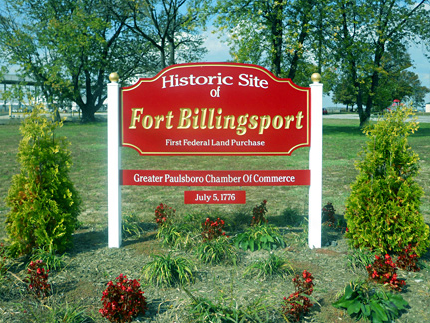
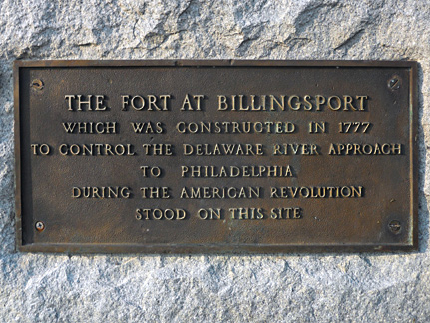
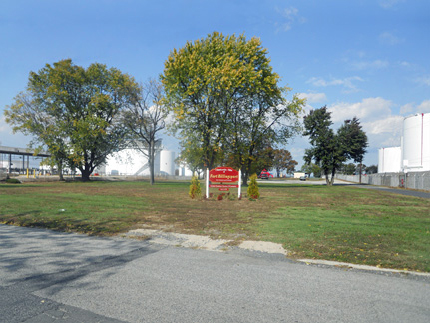
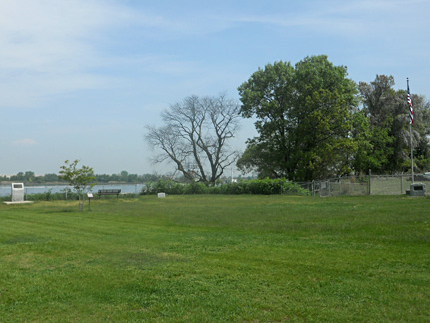
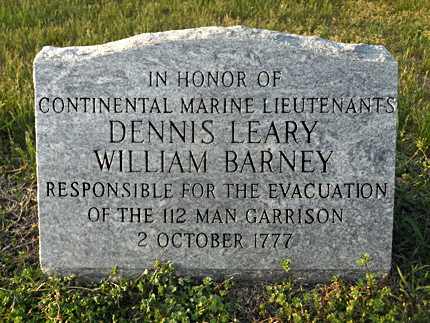
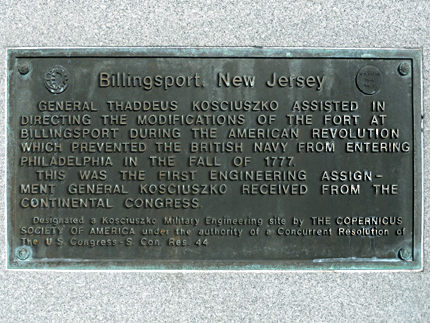
Historic Site of Fort Billingsport
Clonmell Rd. and North Delaware St.
Map / Directions to Fort Billingsport
Now a public park, located between the oil refineries along the Delaware River. In addition to several small monuments, there are picnic tables, and a great view of the Delaware River.
When the Continental Congress adopted the Declaration of Independence in Philadelphia on July 4, 1776, it created the new country of the United States of America. The following day, Congress made the new country's first federal land purchase, a one-hundred-acre plot of land located at this site on the Delaware River, where Fort Billingsport was then constructed.
Fort Billingsport was part of a series of defenses created to keep the British from sailing up the Delaware River to reach the national capital at Philadelphia. The defenses included two other forts in the area, Fort Mercer about ten miles upriver from here on the New Jersey side, and Fort Mifflin on the other side of the Delaware River.
In addition to the forts, a system of obstructions called cheaveaux de frise were placed in the Delaware River. These were large boxes with long wooden spikes stuck out of them, to impale the British ships which might make it up the Delaware River. One row of these, known as the lower cheaveaux de frise, stretched from Fort Billingsport to a group of American ships on the other side of the river.
If the British attempted to remove the cheaveaux de frise, it would require a great deal of time and effort using two ships. Having Fort Mercer on the shore alongside meant that in the time it would take the British to attempt to remove the cheaveaux de frise, cannon fire from Fort Mercer could sink their ships.
The British learned of these defenses and, realizing that they could not sail their ships up the Delaware River, decided to invade Philadelphia by a different route. They sailed up the Chesapeake to a point where they could disembark and then march fifty miles to Philadelphia. Although this route was longer and required the lengthy march, it avoided the cheaveaux de frise and allowed the British to take Philadelphia on September 26, 1777.
British Attack on Fort Billingsport
With British forces in Philadelphia, the situation changed greatly for Fort Billingsport. The fort had been built as part of defenses to keep the British out of Philadelphia. It was not designed for the situation of having them already in Philadelphia.
When the fort was constructed, it was assumed that any attack would come from downriver, because the British roundabout way of taking Philadelphia had not been anticipated. Therefore, its defensive walls faced downriver, leaving the fort insufficiently protected from an attack from other directions.
Also, with the British in Philadelphia, they were able to bring cannon to the Pennsylvania side of the Delaware River, opposite Fort Billingsport.
Realizing these facts, on September 28, two days after the British occupied Philadelphia, General Washington ordered the evacuation of the men stationed at Fort Billingsport to Fort Mifflin across the Delaware River. Unknown to Washington and the troops at Fort Billingsport, approximately 1500 British troops had that same day begun marching from Philadelphia with the intent of capturing Fort Billingsport. They crossed the Delaware River into New Jersey about ten miles south of Paulsboro, and then marched toward Fort Billingsport. Along the way they encountered and exchanged fire with New Jersey militia under Brigadier General Silas Newcomb. The New Jersey militiamen were greatly outnumbered, and they retreated.
Colonel William Bradford, in command of Fort Billingsport, ordered an evacuation of the 112 men in the fort on October 2. The men were brought out to Fort Mifflin on boats by two Continental Marine Lieutenants, William Barney and Dennis Leary, who succeeded in safely evacuating all of the men and much of the ammunition. The park contains a small monument to Leary and Barney (shown left).
After the evacuation of American troops from Fort Billingsport, the British took control of the fort. However, their goal was not primarily the occupation of the fort, but the dismantling of the cheaveaux de frise which they were now free to do without being fired on from Americans in the fort.
The British briefly evacuated the fort on October 6, upon hearing that American forces in strength were in the area. The Americans did not attempt to retake the fort because they knew that the British would return in greater strength, which they did the next day.
The British were soon able to open up the passageway from the cheaveaux de frise, which permitted the free passage of British ships to Philadelphia to bring supplies into the city. They occupied the city until June 18, 1778. [1]
In addition to being the first Federal Land Purchase, Fort Billingsport was another significant first. It was General Thaddeus Kościuszko's first engineering assignment in America.
Born in Poland in 1746, Thaddeus Kościuszko was an officer and talented military engineer who came to America in 1776 to fight on the American side in the Revolutionary War.
A plaque on a small monument in the park pays tribute to Kościuszko's role in engineering Fort Billingsport. [2]
Kościuszko's second engineering assignment was at nearby Fort Mercer, several miles west of here on the Delaware River. A similar plaque is located in Red Bank Historical Park at the site where Fort Mercer stood. The Battle of Red Bank occurred there on October 22, 1777, twenty days after the American evacuation of Fort Billingsport.
There is a bust sculpture of Kościuszko about ten miles from here; it is part of the Polish American Congress Monument in Pennsauken.

1. ^ • Samuel Stelle Smith, Fight for the Delaware, 1777 (Monmouth Beach, N.J.: Philip Freneau Press, 1970) pages 8-11
• Charles R. Smith, Marines in the Revolution - A History of Continental Marines in the American Revolution 1775-1783 (Washington D. C.: U.S. Government Printing Office, History And Museums Division, Headquarters, U. S. Marine Corps, 1975) pages 123-128
2. ^ The plaque states, "Designated a Kościuszko Military Engineering site by the Copernicus Society of America under the authority of a Concurrent Resolution of The U.S. Congress - S. Con. Res. 44"
▸ The resolution referred to was the "Kościuszko Military Engineering Sites" resolution which was agreed to April 3, 1978
The text of this Resolution can be read in two PDFs on the Government Publishing Office website here and here